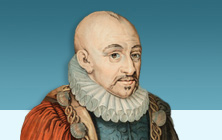Sebond and scepticism
So men having tried, and sounded all, and in all this Chaoes and huge heape of learning and provision of so infinite different things, and found nothing that is substantiall, firme and steadie, but all vanitie, have renounced their presumption, and too late knowen their naturall condition. (Essais II.12, ‘An apology for Raymond Sebond’, trans. Florio)
In 1565, Montaigne married Françoise de La Chassaigne, the daughter of another member of the Parlement. Around 1567, Montaigne’s father set him the task of translating the Natural theology, or Book of creatures of the Catalan scholar Raymond Sebond (d. 1436). He did not live to see it printed: whilst Montaigne was in Paris arranging its publication, news came of his father’s death. Some years later, Montaigne was asked to write a defence of Sebond’s work, which had caused controversy by seeking to demonstrate the truth of Christianity through contemplation of the natural world, rather than through scripture or the authority of the Church. Montaigne’s defence became the ‘Apology for Raymond Sebond’ of the Essais—in fact only tangentially concerned with its nominal subject, and rather an extended meditation on the fallibility of human reasoning, summed up in his famous motto of the time, Que sçais-je? (‘What do I know?’).
(Click to enlarge the image)


